"මල්" හි සංශෝධන අතර වෙනස්කම්
සුළු පරිවර්තනය |
සුළු පරිවර්තනය |
||
| 64 පේළිය: | 64 පේළිය: | ||
මේ ආකාරයට ශාක හා පරාගන කාරක සතුන් අතර ඇති සම්භන්ධය වරෙක ඔවුන් දෙකොට්ටාශයේම අවාසියකට හේතුවිය හැක.මන්ද එක් විශේෂයකට සිදුවන හානිය අනෙත් විශේෂයේ පැවැත්මට ඍජුව බලපාන බැවිනි. |
මේ ආකාරයට ශාක හා පරාගන කාරක සතුන් අතර ඇති සම්භන්ධය වරෙක ඔවුන් දෙකොට්ටාශයේම අවාසියකට හේතුවිය හැක.මන්ද එක් විශේෂයකට සිදුවන හානිය අනෙත් විශේෂයේ පැවැත්මට ඍජුව බලපාන බැවිනි. |
||
== සංසේචනය හා ව්යාප්තිය == |
|||
== Fertilization and dispersal == |
|||
{{මූලික|biological dispersal}} |
|||
[[ගොනුව:Cassia.jpg|thumb|[[Cassia Fistula]]. A hermaphrodite flower showing both male and female parts.]] |
[[ගොනුව:Cassia.jpg|thumb|[[Cassia Fistula]]. A hermaphrodite flower showing both male and female parts.]] |
||
ස්ත්රී හා පුරුෂ කොටස් දෙකම ඇති ද්ළුීලිංගික පුෂ්ප බොහෝවිට ස්වපරාගනය සිදුකරයි.මෙම ස්වපරාගනය සිදුවන ශාකවල ජානමය වෙනස්වීම් ඉතා අඩුවෙන් සිදුවේ.මෙම හේතුව නිසා පරිසරයට ඔරෝත්තු දියහැකි නව ප්රභේදයන් බිහිවීම අවමවේ.ඇතැම් පුෂ්පයන්හි ස්වපරාගනය වැළැක්වීමට විශේෂයෙන් හැඩගැසී ඇති ආකාරය දක්නට ලැබේ.උදාහරණ ලෙස වැල් දොඩම් ශාකය දැක්විය හැක. |
|||
Some flowers with both stamens and a pistil are capable of self-fertilization, which does increase the chance of producing seeds but limits genetic variation. The extreme case of self-fertilization occurs in flowers that always self-fertilize, such as many [[dandelion]]s. Conversely, many species of plants have ways of preventing self-fertilization. Unisexual male and female flowers on the same plant may not appear or mature at the same time, or pollen from the same plant may be incapable of fertilizing its ovules. The latter flower types, which have chemical barriers to their own pollen, are referred to as self-sterile or self-incompatible (see also: [[Plant sexuality]]). |
|||
පුෂ්පයන්හි ඇති පරාග පුෂ්පයේ කලංකය මතට වැටීමෙන් පසු ප්රරෝහනය වන පරාගය ඩිම්බ කෝෂය දක්වා වර්ධනයවී පරාගයේ න්යෂ්ටිය හා ඩිම්බයේ න්යෂ්ටි හාවීමෙන් සංසේචනය සිදුවේ.පසුව සංසේචනයවූ ඩිම්බ බීජ ලෙසත් ඩිම්බ කෝෂය ඵලාවරණය ලෙසත් වර්ධනය වෙයි. |
|||
මෙසේ වර්ධනයවූ ඵලයේ බීජ ව්යාප්තිය සදහා ශාක මගින් විවිධ උපක්රම භාවිත කරයි.උදාහරණ ලෙස සතුන් මගින් ජලය මගින් හා වාතය මගින් හා ස්ඵෝටනය මගින්ද බීජ ව්යාප්තිය සිදුකරයි.. |
|||
== පරිනාමය == |
== පරිනාමය == |
||
05:36, 11 නොවැම්බර් 2016 තෙක් සංශෝධනය
ලොව සුවඳ විහිදවමින් ස්වාභාවිකවම හටගන්නා ඒ අපූර්වතම වස්තුව මලයි.

මල් යනු ශාකයන්හි ලිංගික ප්රජනන අවයවයකි.ජීව විද්යාඥයන්ට අනුව මල්වල පුරුෂ හා ස්ත්රී ලිංගික කොටස් දක්නට ලැබේ,පුරුෂ කොටස ලෙස පරාගද ස්ත්රී කොටස ලෙස කලංකයද මල් තුල ප්රධාන වශයෙන් දක්නට ලැබේ.ස්ත්රී හා පුරුෂ කොටස් එක්වීම පරාගනය මගින් සිදුවේ.මෙම පරාගනය මගින් සිදුවන ලිංගික සංසේචනය මගින් නව පරපුරකට උපතදියහැකි බීජ නිපවීම සිදුවේ.මෙම පරාගනය ක්රම දෙකකට සිදුවේ ඒ ස්වපරාගනය හා පරපරාගනය වශයෙනි.
මීට අමතරව ශාක වල ප්රජනන අවයවය වූ මල් අලංකරණ කටයුතු සදහාද යොදා ගනී.මල් වල ඇති සුන්දරත්වය හා සුගන්දවත්බව එයට හේතුවයි.ඇතැම් මල් ආහාර ලෙසද යොදාගනී.
මල් විශේෂීකරණය හා පරාගනය
මල් සහිත ශාක එහි ඇති මල්වල පරාග පතුරුවාහැරීම සදහා විවිධ ක්රම යොදාගනී.මෙම ශාක සුළග මගින් ජලය මගින් මෙන්ම සතුන් මගින්ද පරාගනය සිදුකරයි.ඇතැම් ශාක මෙම ක්රමවලින් කිහිපයක්ම යොදා ගනී.
ඇතැම් ශාක ස්වපරාගනය සිදුකරයි .

සපුෂ්පික ශාක තම පරාගන ක්රියාවලිය පහසු කරගැනීම විවිධ සැකසුම් සහිතව සකස්වී ඇත.සතුන් මගින් පරාගනය සිදුවන ශාකවල සතුන් ආකර්ෂණය සදහා පරාගධානියට ආසන්නව මල්පැණි පිහිටා ඇත.මල්පැණි ලබාගැනීමට මලවෙත එන සතුන්ගේ සිරුරේ පරාග තැවරීම සිදුවන අතර තවත් මලක පැණි උරාබීමට යන විට කලින් ගෑවී තිබූ පරාග අදාල පුෂ්පයේ කලංකය මත පතිතවීමෙන් මලක පූමාංගී හෙවක් පුරුෂ සෛල හා කලංකයමත ඇති ජායාංගී හෙවත් ස්ත්රී සෛල සංසේචනයවීම සිදුවේ.මෙම සතුන් මගින් පරාගනය සිදුවන සපුෂ්පික ශාක සතු මල් ඉතා අලංකාර හා සුගන්දවත්ය.බොහෝවිට දිවා කාලයේ පිපෙන මල් විවිධ වර්ණ රටාවලින් අලංකාර වී ඇති අතර රාත්රියේ පිපෙන මල් සුදු පැහැති වන අතර ඉතා මිහිරි සුගන්දයක් විහිදුවයි.උදාහරණ ලෙස පිච්ච කඩුපුල් ඇට්ටේරියා ආදී පුෂ්ප දැක්විය හැක.දිවා කාලයේ පිපෙන මල් විචිත්ර වර්ණ සහිත අලංකාරව පිපී තිබීම නිසා මල්පැණි බීමට එන සතුන්ට පහසුවෙන් දැකගැනීමට හැකිවේ.රාත්රී කාලයේ පිපෙන මල් සුදු පැහැ වර්ණයෙන් යුක්ත වීමත් ඉතා මිහිරි සුවදක් විහිදීමත් නිසා නිශාචර සතුන්ට පහසුවෙන් ලංවීමට හැකිවේ.

ඇතැම් සපුෂ්පිත ශාක තම පරාගනය සිදු කරන්නේ සුළග මගිනි.මේ වර්ගයට තෘණ පවුලට අයත් ශාක,මුර්ජ ශාක,මේපල් ශාක තාල වර්ගයට අයත් ශාක ආදිය ගතහැක.මෙම වර්ගයට අයත් මල් එකවර විශාල සංඛාවක් හටගනී මෙවාහි පරාග ඉතා සැහැල්ලු වන අතර විශාල පරාග ප්රමාණයක් නිපදවයි.බොහෝවිට මෙම මල් ස්ත්රී හා පුරුෂ වශයෙන් වෙන්වෙන්ව පවතී.පුරුෂ කොටස් පමණක් ඇති පූමාංගී මල් ඉතා විශාල සංඛ්යාවක් වරෙකට නිපදවේ.පුරුෂ කොටස් පමණක් ඇති පූමාංගී මල් කුඩා වන අතර ස්ත්රී කොටස් පමණක් ඇති ජායාංගී පුෂ්ප තරමක් විශාලව වැඩේ.මෙම සුළග මගින් පරාගනය වන පුෂ්ප වල අලංකාර වර්ණවත් බවක් හෝ සුගන්දවත් බවක් නැත.
රූපාකරය
සපුෂ්ක ශාක වල ප්රජනනය සිදුකෙරෙන බීජානු පරාග හා ඩිම්බ වශයෙන් වර්ග දෙකකට බෙදේ.ඒ අනුව ශාකයක ස්ත්රී හා පුරුෂ ප්රජනන කොටස් ද්විත්වයම ශාක පුෂ්පයක අන්තර්ගතය.කෙසේ වෙතත් ඇතම් ශාක වල පුෂ්ප තුල පුරුෂ කොටස් පමණක්ද තවත් කොටසක ස්ත්රී පුෂ්ප කොටසද දක්නට ලැබේ.උදාහරණ ලෙස වට්ටක්කා මලේ ස්ත්රී පුෂ්පය හෙවත් ජායාංගී පුෂ්පයත් පුරුෂ කොටස් ඇතුලත් පූමාංගී පුෂ්පත් වෙනවෙනම දක්නට ලැබේ.තවත් ශාකවල ඣායාංගි පුෂ්ප එක් ශාකයකත් පූමාංගී පුෂ්ප තව ශාකයකත් වැඩේ.උදාහරණලෙස පැපොල් වෘක්ෂ වල මේආකාර විශේදනයක් දක්නට ලැබේ.
ශාක පුෂ්පයන්හි ව්යුහය මීලගට සලකා බලමු.

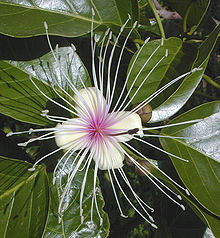
- මණිපත්රය මල් පෙති වලට පිටතින් ඇති කොළ පැහැති ආවරණය.
- මුකූටය:මලේ පෙති වලට ඇතුල් පැත්තෙට වෙන්නට ඇති සිහින් සුමුදු දඩුවක ආකාරගත් අංගයකි.මෙහි අග පරාග තැන්පත්ව පවතී.මෙය මල් රේණු නමින්ද හදුන්වයි.මෙහි පාලජම්බුල කිරණවලට සංවේදී පෙදෙසක් පවතී.එමගින් මල් පැණි බීමට එන සංයුක්ත ඇස් ඇති සතුන්ට මල් පැණි ඇති පෙදෙට ගමන් කිරීමට පහසුවේ.(සංයුක්ත ඇස් ඇති සතුන්ට පාලජම්බුල කිරණ සංවේදීවේ).
- පූමංගය මුකූටය අග ඇති පරාගධානියයි.මෙය තුල පරාග විශාල ප්රමාණයක් නිපදවෙයි.මෙය මලක පුරුෂ කොටසට අයත් ප්රධාන උපාංගයයි.
- ජායාංගය මෙය පුෂ්පයක ප්රධාන ස්ත්රී ලිංගික කොටසයි.මෙයට කලංකය ඩිම්බ බිම්බ කෝෂය අයත්වේ.ඇතැම් පුෂ්පවල එක් ඩිම්බකෝෂයක්ය හා එක් ඩිම්බයක් පමණක් පවතී.තවත් පුෂ්පවල ඩිම්බ කෝෂය තුල ඩිම්බ කිහිපයක් දක්නට ලැබේ. .
මලක ව්යුහය පොදුවේ ඉහත පරිද් දැක්වුවද එකිනෙකට අසමාන විවිධ වෙනස්කම් මල්තුල දක්නට ලැබේ.මෙම වෙනස්කම් සදහා පරිණාමීය සාධක ප්රෙව්ණිගත සාධක පාරිසරික සාධක ආදිය බලපායි.එකම පවුලකට අයත් විශේෂයක වුවද විවිධ වෙනස්කම් දක්නට ලැබේ.
බොහෝ පුෂ්පයන්හි ජායාංගි හා පූමාංගි කොටස් දෙකම එකම පුෂ්පයක දක්නට ලැබේ.මෙවැනි පුෂ්ප ද්වීලිංගික පුෂ්ප යනුවෙන් හදුන්වයි.ඇතම් පුෂ්පවල ජායාංගී කොටස හා පූමාංගී කොටස වෙන වෙනම පිහිටා ඇත.මෙවැනි පුෂ්ප එ්ක ලිංගික පුෂ්ප යනුවෙන් හදුන්වයි.පූමංගී කොටස පමණක් ඇති පුෂ්ප පූමංගී පුෂ්ප ලෙසත් ජායාංගී කොටස් පමණක් ඇති පුෂ්ප ජායාංගී පුෂ්ප ලෙසත් හදුන්වයි.මෙවැනි පුෂ්පයන්ට උදාහරණ ලෙස වට්ටක්කා කරවිල වැටකොළු ආදී පුෂ්ප දැක්විය හැකිය.බොහෝවිට මෙම ජායාංගී හා පූමාංගී පුෂ්ප එකම ශාකයක වර්ධනය වෙයි.එවැනි ලක්ෂණ සහිත ශාක ඒකගෘහී ශාක යනුවෙන් හදුන්වයි.එහෙත් තවත් ශාකයන්හි ජායංගී පුෂ්පය එක ශාකයකත් තවත් ශාකයක පූමංගී පුෂ්ප ලෙසත් වෙන වෙනම වර්ධනයවේ.මෙවන් ශාක ද්වීගෘහි ශාක යනුවෙන් හදුන්වයි.

මල් වල හැඩය ප්රමාණය විශාලත්වය අනුව එකිනෙකින් වෙනස්වේ.විවිධ පුෂ්පවල මණි පත්රෙය් හැඩය හා ප්රමාණය ද වෙනස්ය.ඇතැම් පුෂ්පවල මණියට අමතරව උප මණියක්ද දක්නට ලැබේ.විවිධ පුෂ්පවල දල ප්රමාණය එකිනෙකට වෙනස්ය.ඇතැම් පුෂ්ප වලට ඇත්තේ එක් දලයක් පමණි.උදාහරණලෙස ඇන්තූරියම් පුෂ්පය දැක්විය හැක.තවත් මල්වල දල දෙකක් තුනක් ආදී වශයෙන්ද දක්වට ලැබේ බහුලව දක්නට ලැබෙන්නේ දල හතරක් හෝ පහක් ඇති පුෂ්පයි.ඇතඅම් පුෂ්පවල දල හයක් අටක් හෝ විශාල දල ප්රමාණයක් ඇති පුෂ්පද දැකිය හැකිය.පූමංගය හෙවත් රේණුවල ස්වභාවය අනුවද මල් එකිනෙකට වෙනස්වේ.ඇතුම් පුෂ්පවල රේණු කිහිපයක් දක්නට ලැබේ.රේණුවේ දණ්ඩ හෙවත් සූත්රිකා විවිධ දිගින් යුක්තව දක්නට ලැබේ.ඇතැම් මල්වල සූත්රිකා කුඩාවට පිහිටා ඇති අතර තවත් මල්වල සූත්රිකා දික්ව පිහිටා ඇත.
ඵල හටගැනීම
පුෂ්පයක කලංකයමත ඇලෙනසුලු සීනි ද්රාවණයක් පවතී.පරාගකයේ දී කලංකයමත පතිතවන පරාග කංලකයමත ඇති ද්රාවණයේ ප්රෙරා්හණයවීමට පටන්ගනී.මෙහිදී පරාග බිත්තියේ තුනී ස්ථානයකිත් රාගය තුල ඇති සෛල ප්ලාස්මය නළයක්සේ පිටතට වර්ධනයවේ.මෙය පරාග නාලය නමින් හදුන්වයි.පරාගයේ න්යෂ්ටියද පිටතට පැමිනේ.ඉන්පසු මෙය කීලය දිගේ වර්ධනයවී පුෂ්පයේ ඩිම්බ කෝෂය දෙසට ලගාවෙයි.ඩිම්බය තුල පවතින ඩිම්බ අනුද්වාරයනම් සිදුරෙන් ඇතුළුවී පරාගයේ න්යෂ්ටියත් ඩිම්බයේ න්යෂ්ටියත් සම්බන්ධවී සංසේචනය සිදුවේ.මෙසේ සංසේචනයවූ පුෂ්පයේ දල පරවී වැටේ.මලක අනෙකුත් කොටස් මිය යද්දී ඩිම්බ බීජ බවටත් ඩිම්බ කෝෂය ඵලාවරණය ලෙසත් වර්ධනයවීම ඇරඹේ.
පරාගනය
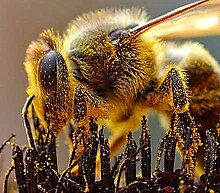

ශාකයක ලිංගික ප්රජනනයේ මූලික අවස්තාව පරාගනයයි.ශාකයක ප්රධාන ලිංගික අවයවය එහි පුෂ්පයන්ය.පුෂ්පයක ඇති පරාග ඩිමබ හා සංසේචනයවීමේ ක්රියාවලිය සරලව පරාගනය ලෙස දැක්විය හැක.පරාග හෙවත් පූමාංගී සෛලවල න්යෂ්ටිය හා ඩිමබ වල න්යෂ්ටිය හාවීම සංසේචනය යනුවෙන් හදුන්වයි.සමාන්යයෙන් පරාග ශාකයකින් ශාකයකට ගමන්කරයි.එහෙත් ඇතැම් ශාක ස්වපරාගනය සිදුකරයි.මේ ආකාරයට ස්වපරාගනය සිදු වන්නේ එකම පුෂ්පයක ස්ත්රී හා පුරුෂ කොටස් දෙකම ඇති පුෂ්පයන් ඇති ශාක වලය.සංසේචනය වූ ඩිමබ මගින් පමණක් ඉදිරි පරම්පරාව ගෙනයාහැකි බීජ නිපදවයි. පුෂ්පයන් පරාගනය සදහා විවිධ රූපාකරයන් අනුව හැඩගැසී පවතී.ඇතැම් පුෂ්ප සතුන් මගින් පරාගනය වීමටත් ඇතැම් පුෂ්ප වාතය මගින් පරාගනය වීමටත් තවත් සමහර පුෂ්ප ජලය මගින් පරාගනය වීමටත් හැඩගැසී ඇත.සතුන් මගින් පරාගනය වීමට හැඩගැසී ඇති පුෂ්ප සදහා කෘබීන් කුරුල්ලන් හා වවුලන් වැනි සතුන්ගේ සහය හිමිවේ.
ආකර්ශන උපක්රම

ශාකයකට එක්තැනක සිට තවත් තැනකට සංචරණය වීමට නොහැකිය.එම නිසා සංචරණය වියහැකි සතුන්ගේ සහය පරාගනය සදහා ශාකයන් විසින් උපයෝගීකරගනී.පරාගනයේ දී ශාකයන්ට වැඩිපුරම සහය ලබා දෙන්නේ කෘබීන්ය.කෘබින් ආදී පරාගනය සදහා සහය දැක්විය හැකි සතුන් ආකර්ශන සදහා මල් වල විශේෂ හැඩගැසීම් පෙන්වයි.සතුන් මගින් පරාගනය සිදුවන මල්වල මධුකොෂයක් පිහිටයි.මෙහි රසවත් මල්පැණි පිරී පවතී.එම මල්පැණි බීමට මීමැස්සන් කෘබීන් කුරුල්ලන් පැමිනේ.මෙම මල්වල පරාගධානියේ සිට මධුකෝෂය දක්වා දෘෂ්ය ආලෝකයට සංවේදී නොවන එහෙත් පාරජම්බුල කිරණවලට සංවේදී ගමන් මාර්ගයක් පිහිටා ඇත.මෙම ගමන් මාර්ගය විශේෂයෙන් සංයුත්ත ඇස් ඇති සතුන්ට හොදින් දර්ශනයවේ.දිවා කාලයේ පිපෙන මල් විවිධ වර්ණයන්ගෙන් සමන්විය.මෙම විචිත්ර වර්ණ රටා සතුන් ආකර්ශනය කරගැනීමට හැකිය.එහෙත් රාත්රී කාලයේ පිපෙන මල් සතුන් ආකර්ශනය කරගැනීම සදහා සුවද විහිදුවීම සිදුකරයි.එසෙම එම මල් බොහෝවිට සුදු පැහැතිය.ඇතැම් මල් වලින් නිකුත් කරන සුගන්දයන් මිනිස් නාසයට සංවේදීවේ නොවේ.තවත් ඇතැම් මල් මිහිරි සවදක් වෙනුවට නිකුත් කරන්නේ අමිහිරි දුර්ගන්ධයන්ය.උදාහරණ ලෙස රැෆ්ලේසියා කිඩාරම් ආදිය දැක්විය හැක.මෙම මල් පරාගනයවීම සිදුවන්නේ වවුලන් සළබයන් ආදී සතුන් මගිනි.
ඇතැම් මල් පරාගනය සදහා අමුතු හැසිරීම් දක්වයි.උදාහරණ ලෙස ඇතැම් ඕකිඩ් මල් ගැහැණු මීමැස්සන්ගේ වර්ණය හැඩය ගැනීම මෙන්ම ගැහැණු මීමැස්සන් ගේ සුවන විහිදුවයි.මෙවිට පිරිමි මීමැස්සන් ගැහැණු මීමැස්සන් යැයි සැකකර සංසර්ගය සදහා පැමිනේ.
පරාගන යාන්ත්රණය
පරාගන යාන්ත්රණය ශක අනුව වෙනස්වේ.බොහෝ පුෂ්පයන් ප්රධාන වශයෙන් කොටස් දෙකකට බෙදේ.
කෘබිකාමී(Entomophilous): මෙම වර්ගයට අයත් මල් පරාගනය සදහා කෘබීන් වවුලන් හෝ වෙනත් සතුන් උපයොගීකරගනී.නිතරම මෙම වර්ගයට අයත් මල් කෘබීන් ආකර්ශනය කරගැනීමට හැඩගැසී ඇත.විචිත්ර වර්ණ දැරීම සුගන්දයන් විහිදුවීම මධුකෝෂ පිහිටා තිබීම ඉන් කිහිපයකි.මෙමගින් ස්වපරාගනය වලක්වා පරපරාගනය සිදුවීම පහසු කරවයි.වඩාත් උසස් ඉදිරි පරම්පරාවක් බිහිකිරීමට නම් පරපරාගනය වඩාත් උචිතය.ඇතැම් ශාක ස්වපරාගනය වැළැක්වීමට හැඩගැසී පවතී.
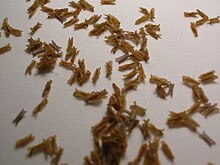
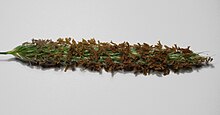
වාතකාමී(Anemophilous): ඇතැම් පුෂ්පයන් වාතය මගින් පරාගනයවීමට හැඩගැසී ඇත.තෘණ කුලයට අයත් ශාක හා තාල වර්ගයට අයත් ශාක වැනි විවිධශාක වර්ග මෙම ගණයට අයත්ය. මෙම ශාකවලට කෘබිකාමී ශාක වලට මෙන් කෘබීන් ආකර්ශනය කරගැනීමට අවශ්ය නැතතඑබැවින් මෙම පුෂ්ප අලංකාර හෝ සුගන්දවත් බවක් නොපෙන්වයි.මෙම පුෂ්ප බොහෝ විට කුඩාය.පරාග ඉතා සැහැල්ලුය සුළගේ පාවී යන පරාග පුෂ්පයක කලංකය මත පතිතවීමෙන් සංසේචනය සිදුවේ.මෙම පුෂ්පයන් පරාග ඉතා විශාල සංඛාවක් නිපදවයි.
බොහෝ පුෂ්පයන් ස්වපරාගනය සිදු කරන අතර ඇතැම් ශාකවල ස්වපරාගනය වැළැක්වීම සදහා හැඩගැසී පවතී.
පරාගන සම්භන්ධතා
පරාගනයේ දී පුෂ්පයන් හා කෘබීන් ආදී පරාගන කාරක සතුන් අතර විවිධ සම්භන්ධතා දැකිය හැකිය.ඇතැම් පුෂ්පයන් කරා ලගාවන්නේ එක් විශේෂයකට අයත් කෘබීන් පමණය.එබැවින් ඇතැම් ශාක වෙනත් භූගෝලීය කලාපයක සරුවට වැඩුනද ඵල හටගැනීම සිදු නොවේ.එයට හේතුව එම මල් පරාගනය කිරීමට සුදුසු සත්ව විශේෂය එහි නොසිටීමයි.එසෙම පරාගන කාරක සතුන් යම් හෙයකින් වදවී ගියහොත් හෝ ආපදාවකට පත්වු හොත් අදාල ශාකයන්හි ඵල හටගැනීම සිදුනොවේ.උදාහරණ ලෙස මැලේසියාවේ සිදුවූ අධික හිරිගල් ගුහා කඩා දැමීමත් සමග වවුලන් දහස් ගණනකට තම වාසස්ථාන අහිමිවිය.ඒ සමගම එරට දූරියන් ඵලදාව ඉතා විශාල ලෙස අඩුවිය.එයට හේතුව ඩූරියන් පුෂ්ප පරාගනයට වවුලන් දායකවූ බැවිනි.මේ ආකාරයට යම් ශාකයකට අයත් පරාගන කාරක සත්වයින්ට වන හානියත් සමග එම ශාකයන්හි ඵලදාව අඩුවේ.
මේ ආකාරයට ශාක හා පරාගන කාරක සතුන් අතර ඇති සම්භන්ධය වරෙක ඔවුන් දෙකොට්ටාශයේම අවාසියකට හේතුවිය හැක.මන්ද එක් විශේෂයකට සිදුවන හානිය අනෙත් විශේෂයේ පැවැත්මට ඍජුව බලපාන බැවිනි.
සංසේචනය හා ව්යාප්තිය

ස්ත්රී හා පුරුෂ කොටස් දෙකම ඇති ද්ළුීලිංගික පුෂ්ප බොහෝවිට ස්වපරාගනය සිදුකරයි.මෙම ස්වපරාගනය සිදුවන ශාකවල ජානමය වෙනස්වීම් ඉතා අඩුවෙන් සිදුවේ.මෙම හේතුව නිසා පරිසරයට ඔරෝත්තු දියහැකි නව ප්රභේදයන් බිහිවීම අවමවේ.ඇතැම් පුෂ්පයන්හි ස්වපරාගනය වැළැක්වීමට විශේෂයෙන් හැඩගැසී ඇති ආකාරය දක්නට ලැබේ.උදාහරණ ලෙස වැල් දොඩම් ශාකය දැක්විය හැක.
පුෂ්පයන්හි ඇති පරාග පුෂ්පයේ කලංකය මතට වැටීමෙන් පසු ප්රරෝහනය වන පරාගය ඩිම්බ කෝෂය දක්වා වර්ධනයවී පරාගයේ න්යෂ්ටිය හා ඩිම්බයේ න්යෂ්ටි හාවීමෙන් සංසේචනය සිදුවේ.පසුව සංසේචනයවූ ඩිම්බ බීජ ලෙසත් ඩිම්බ කෝෂය ඵලාවරණය ලෙසත් වර්ධනය වෙයි.
මෙසේ වර්ධනයවූ ඵලයේ බීජ ව්යාප්තිය සදහා ශාක මගින් විවිධ උපක්රම භාවිත කරයි.උදාහරණ ලෙස සතුන් මගින් ජලය මගින් හා වාතය මගින් හා ස්ඵෝටනය මගින්ද බීජ ව්යාප්තිය සිදුකරයි..
පරිනාමය

While land plants have existed for about 425 million years, the first ones reproduced by a simple adaptation of their aquatic counterparts: spores. In the sea, plants—and some animals—can simply scatter out genetic clones of themselves to float away and grow elsewhere. This is how early plants reproduced. But plants soon evolved methods of protecting these copies to deal with drying out and other abuse which is even more likely on land than in the sea. The protection became the seed, though it had not yet evolved the flower. Early seed-bearing plants include the ginkgo and conifers. The earliest fossil of a flowering plant, Archaefructus liaoningensis, is dated about 125 million years old.[1] Several groups of extinct gymnosperms, particularly seed ferns, have been proposed as the ancestors of flowering plants but there is no continuous fossil evidence showing exactly how flowers evolved. The apparently sudden appearance of relatively modern flowers in the fossil record posed such a problem for the theory of evolution that it was called an "abominable mystery" by Charles Darwin. Recently discovered angiosperm fossils such as Archaefructus, along with further discoveries of fossil gymnosperms, suggest how angiosperm characteristics may have been acquired in a series of steps.
Recent DNA analysis (molecular systematics)[2][3] show that Amborella trichopoda, found on the Pacific island of New Caledonia, is the sister group to the rest of the flowering plants, and morphological studies[4] suggest that it has features which may have been characteristic of the earliest flowering plants.
The general assumption is that the function of flowers, from the start, was to involve other animals in the reproduction process. Pollen can be scattered without bright colors and obvious shapes, which would therefore be a liability, using the plant's resources, unless they provide some other benefit. One proposed reason for the sudden, fully developed appearance of flowers is that they evolved in an isolated setting like an island, or chain of islands, where the plants bearing them were able to develop a highly specialized relationship with some specific animal (a wasp, for example), the way many island species develop today. This symbiotic relationship, with a hypothetical wasp bearing pollen from one plant to another much the way fig wasps do today, could have eventually resulted in both the plant(s) and their partners developing a high degree of specialization. Island genetics is believed to be a common source of speciation, especially when it comes to radical adaptations which seem to have required inferior transitional forms. Note that the wasp example is not incidental; bees, apparently evolved specifically for symbiotic plant relationships, are descended from wasps.
Likewise, most fruit used in plant reproduction comes from the enlargement of parts of the flower. This fruit is frequently a tool which depends upon animals wishing to eat it, and thus scattering the seeds it contains.
While many such symbiotic relationships remain too fragile to survive competition with mainland animals and spread, flowers proved to be an unusually effective means of production, spreading (whatever their actual origin) to become the dominant form of land plant life.

While there is only hard proof of such flowers existing about 130 million years ago, there is some circumstantial evidence that they did exist up to 250 million years ago. A chemical used by plants to defend their flowers, oleanane, has been detected in fossil plants that old, including gigantopterids[5], which evolved at that time and bear many of the traits of modern, flowering plants, though they are not known to be flowering plants themselves, because only their stems and prickles have been found preserved in detail; one of the earliest examples of petrification.
The similarity in leaf and stem structure can be very important, because flowers are genetically just an adaptation of normal leaf and stem components on plants, a combination of genes normally responsible for forming new shoots.[6] The most primitive flowers are thought to have had a variable number of flower parts, often separate from (but in contact with) each other. The flowers would have tended to grow in a spiral pattern, to be bisexual (in plants, this means both male and female parts on the same flower), and to be dominated by the ovary (female part). As flowers grew more advanced, some variations developed parts fused together, with a much more specific number and design, and with either specific sexes per flower or plant, or at least "ovary inferior".
Flower evolution continues to the present day; modern flowers have been so profoundly influenced by humans that many of them cannot be pollinated in nature. Many modern, domesticated flowers used to be simple weeds, which only sprouted when the ground was disturbed. Some of them tended to grow with human crops, and the prettiest did not get plucked because of their beauty, developing a dependence upon and special adaptation to human affection.[7]
ලක්ෂණ
 |
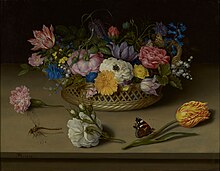 |
 |
Many flowers have important symbolic meanings in Western culture. The practice of assigning meanings to flowers is known as floriography. Some of the more common examples include:
- Red roses are given as a symbol of love, beauty, and passion.
- Poppies are a symbol of consolation in time of death. In the UK, New Zealand, Australia and Canada, red poppies are worn to commemorate soldiers who have died in times of war.
- Irises/Lily are used in burials as a symbol referring to "resurrection/life". It is also associated with stars (sun) and its petals blooming/shining.
- Daisies are a symbol of innocence.
Flowers within art are also representative of the female genitalia, as seen in the works of artists such as Georgia O'Keeffe, Imogen Cunningham, Veronica Ruiz de Velasco, and Judy Chicago, and in fact in Asian and western classical art. Many cultures around the world have a marked tendency to associate flowers with femininity.
The great variety of delicate and beautiful flowers has inspired the works of numerous poets, especially from the 18th-19th century Romantic era. Famous examples include William Wordsworth's I Wandered Lonely as a Cloud and William Blake's Ah! Sun-Flower.
Because of their varied and colorful appearance, flowers have long been a favorite subject of visual artists as well. Some of the most celebrated paintings from well-known painters are of flowers, such as Van Gogh's sunflowers series or Monet's water lilies. Flowers are also dried, freeze dried and pressed in order to create permanent, three-dimensional pieces of flower art.
The Roman goddess of flowers, gardens, and the season of Spring is Flora. The Greek goddess of spring, flowers and nature is Chloris.
In Hindu mythology, flowers have a significant status. Vishnu, one of the three major gods in the Hindu system, is often depicted standing straight on a lotus flower.[8] Apart from the association with Vishnu, the Hindu tradition also considers the lotus to have spiritual significance.[9] For example, it figures in the Hindu stories of creation.[10]
භාවිතයන්


In modern times, people have sought ways to cultivate, buy, wear, or otherwise be around flowers and blooming plants, partly because of their agreeable appearance and smell. Around the world, people use flowers for a wide range of events and functions that, cumulatively, encompass one's lifetime:
- For new births or Christenings
- As a corsage or boutonniere to be worn at social functions or for holidays
- As tokens of love or esteem
- For wedding flowers for the bridal party, and decorations for the hall
- As brightening decorations within the home
- As a gift of remembrance for bon voyage parties, welcome home parties, and "thinking of you" gifts
- For funeral flowers and expressions of sympathy for the grieving
- For worshiping goddesses. in Hindu culture it is very common to bring flowers as a gift to temples.
People therefore grow flowers around their homes, dedicate entire parts of their living space to flower gardens, pick wildflowers, or buy flowers from florists who depend on an entire network of commercial growers and shippers to support their trade.
Flowers provide less food than other major plants parts (seeds, fruits, roots, stems and leaves) but they provide several important foods and spices. Flower vegetables include broccoli, cauliflower and artichoke. The most expensive spice, saffron, consists of dried stigmas of a crocus. Other flower spices are cloves and capers. Hops flowers are used to flavor beer. Marigold flowers are fed to chickens to give their egg yolks a golden yellow color, which consumers find more desirable. Dandelion flowers are often made into wine. Bee Pollen, pollen collected from bees, is considered a health food by some people. Honey consists of bee-processed flower nectar and is often named for the type of flower, e.g. orange blossom honey, clover honey and tupelo honey.
Hundreds of fresh flowers are edible but few are widely marketed as food. They are often used to add color and flavor to salads. Squash flowers are dipped in breadcrumbs and fried. Edible flowers include nasturtium, chrysanthemum, carnation, cattail, honeysuckle, chicory, cornflower, Canna, and sunflower. Some edible flowers are sometimes candied such as daisy and rose (you may also come across a candied pansy).
Flowers can also be made into herbal teas. Dried flowers such as chrysanthemum, rose, jasmine, camomile are infused into tea both for their fragrance and medical properties. Sometimes, they are also mixed with tea leaves for the added fragrance.
මේවාත් බලන්න
යොමුව
- ↑ Flowers Modern & Ancient
- ↑ First Flower
- ↑ Amborella not a "basal angiosperm"? Not so fast
- ↑ South Pacific plant may be missing link in evolution of flowering plants
- ↑ Oily Fossils Provide Clues To The Evolution Of Flowers
- ↑ Age-Old Question On Evolution Of Flowers Answered
- ↑ Human Affection Altered Evolution of Flowers
- ↑ Vishnu
- ↑ Hinduism Today: God's Favorite Flower
- ↑ The Lotus
- Eames, A. J. (1961) Morphology of the Angiosperms McGraw-Hill Book Co., New York.
- Esau, Katherine (1965) Plant Anatomy (2nd ed.) John Wiley & Sons, New York.
